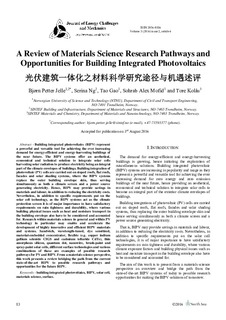A Review of Materials Science Research Pathways and Opportunities for Building Integrated Photovoltaics
Journal article, Peer reviewed
Published version
Permanent lenke
http://hdl.handle.net/11250/2476314Utgivelsesdato
2016Metadata
Vis full innførselSamlinger
- Publikasjoner fra CRIStin - SINTEF AS [5654]
- SINTEF Community [2236]
Originalversjon
Journal of Energy Challenges and Mechanics. 2016, 3 (2), 83-92.Sammendrag
Building integrated photovoltaics (BIPV) represent a powerful and versatile tool for achieving the ever-increasing demand for energy-efficient and energy-harvesting buildings of the near future. The BIPV systems offer an aesthetical, economical and technical solution to integrate solar cells harvesting solar radiation to produce electricity being an integral part of the climate envelopes of buildings. Building integration of photovoltaic (PV) cells are carried out on sloped roofs, flat roofs, facades and solar shading systems, where the BIPV systems replace the outer building envelope skin, thus serving simultaneously as both a climate screen and a power source generating electricity. Hence, BIPV may provide savings in materials and labour, in addition to reducing the electricity costs. Nevertheless, in addition to specific requirements put on the solar cell technology, as the BIPV systems act as the climate protection screen it is of major importance to have satisfactory requirements on rain tightness and durability, where various building physical issues such as heat and moisture transport in the building envelope also must be considered and accounted for. Research within materials science in general and within PV technology may enable and accelerate the development of highly innovative and efficient BIPV materials and systems. Sandwich, wavelength-tuned, dye-sensitized, material-embedded concentrator, flexible (e.g. copper indium gallium selenide CIGS and cadmium telluride CdTe), thin amorphous silicon, quantum dot, nanowire, brush-paint and spray-paint solar cells, different surface technologies and various combinations of these are examples of possible research pathways for PV and BIPV. From a materials science perspective, this work presents a review bridging the path from the current state-of-the-art BIPV to possible research pathways and opportunities for the future BIPV.
